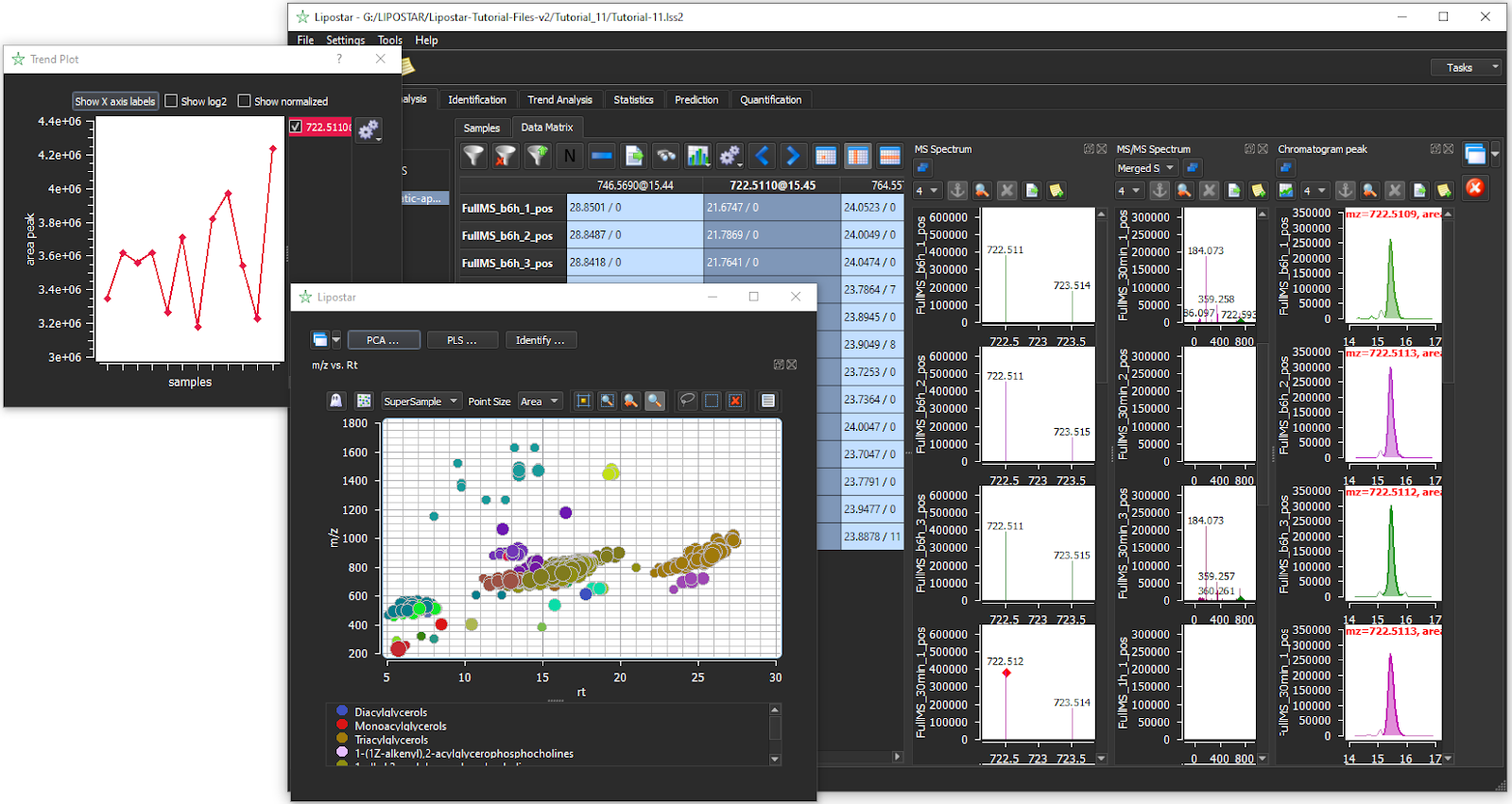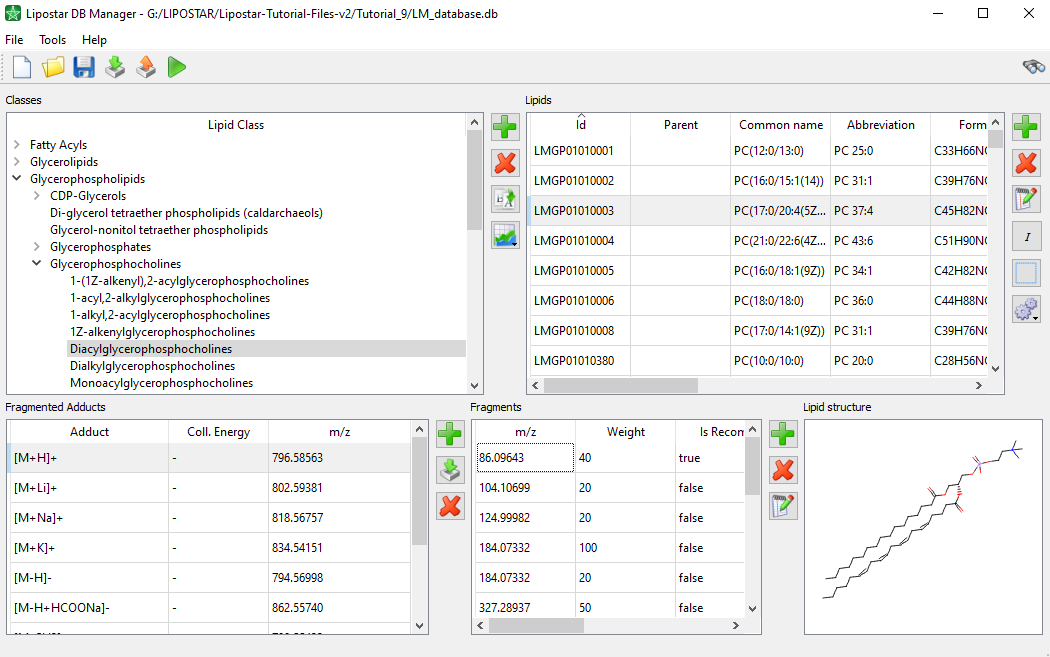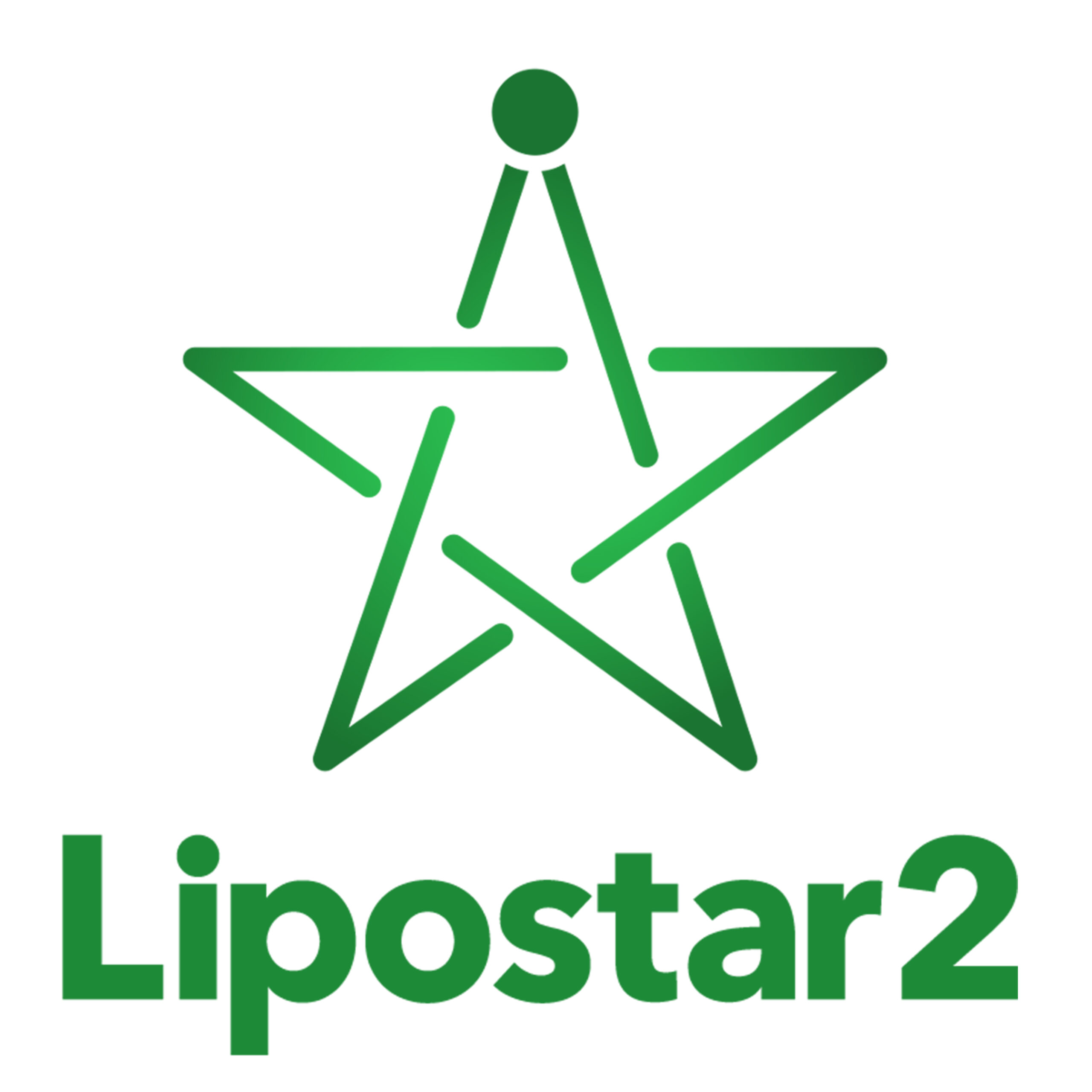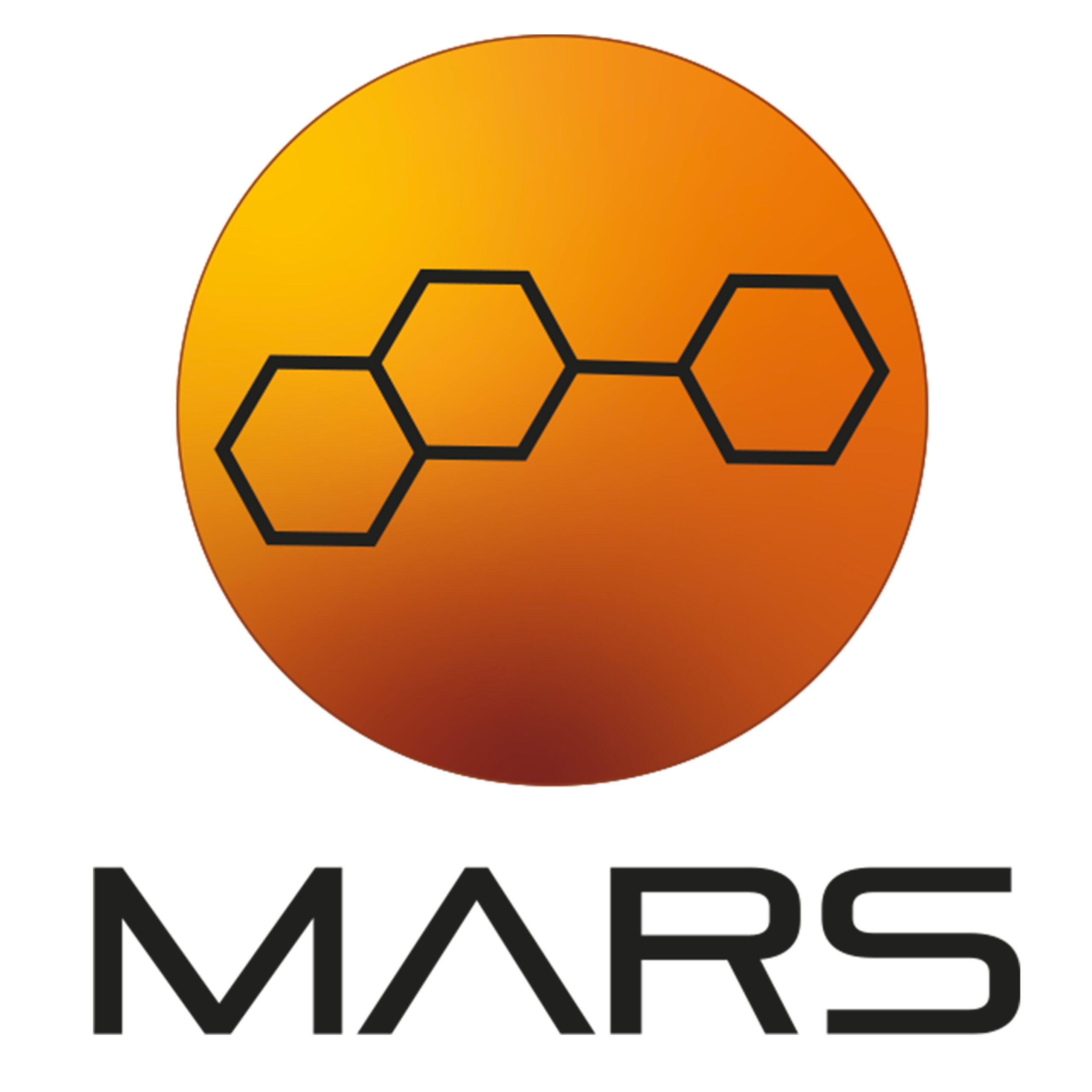Lipostar2 is a comprehensive, vendor-neutral software for LC-MS/MS-based lipidomics (DDA and DIA), which includes a large number of features including: raw data import and peak detection, identification, quantification, statistical analysis, trend analysis and biopathways analysis.
Lipostar2 finds application in untargeted and semi-targeted lipidomics, including stable isotope labelling experiments. Within a Lipostar session, different modes of lipidomics analysis can be combined to increase knowledge and obtain a more comprehensive analysis of lipid profiles.
Key features
- The DB Manager module that enables the generation of databases of fragmented lipids by applying fragmentation rules provided by the software or by importing experimental MS/MS data
- A flexible lipid identification approach that includes:
- a spectral matching approach
- high-throughput bottom-up approach, based on class-specific fragment recognition
- high-throughput identification of oxidized species.
- A gap-filler algorithm to reduce missing values
- Various plots to visualize and refine identification results
- Various multivariate statistical analysis tools
- Lipid pathways


Data Processing
- More instruments supported. Now Lipostar 2 reads the most common file formats:
- Agilent Q-Tof(*.d): AutoMS and full scan at multiple energies of collision (All Ions).
- Waters (*.raw): MSe, HDMSe, DDA, and MSMS, SONAR
- Thermo-Fisher (*.RAW): Ion-Trap and Orbitrap, Exactive, Q-Exactive, DDA and AIF
- ABSCiex *.wiff file format.
- Bruker (*.d): QTof, FT-ICR, TIMS-TOF data dependent scan.
- Shimadzu (*.lcd): QTof
- Data processing can be run in the background.
Data Analysis
- Trend analysis for global lipid profiling
Identification
- New fragmentation rules for automatic lipid identification
- Lipid database generation from in-house data
- Improved adduct and in source fragmentation clustering
- Customized adducts support
- Transfer of identification results to submatrices
- Kendrick mass defect plot
- Use of Waters CCS values for identification scores
Quantification
- New handling of adduct information
Lipid pathways
- Updated and new biopathways maps available (metabolism & disease)
Cross-talk with other software
- Connection to LipidLynxX for lipid annotation
- connection to LPPTiger for in depth identification of oxidized species
Lipostar Training documents. Version 2.1.7
- Tutorial_Lipostar2 Appendix
- Tutorial_Lipostar2_01 Select your style before start
- Tutorial_Lipostar2_02 The Lipostar DB manager
- Tutorial_Lipostar2_03 Generating a database of in-house data
- Tutorial_Lipostar2_04 The Lipid Builder in DB Manager
- Tutorial_Lipostar2_05 First steps into Lipostar
- Tutorial_Lipostar2_06 Search for drug metabolites in data matrix
- Tutorial_Lipostar2_07 Lipostar for Flux analysis
- Tutorial_Lipostar2_08 Exploring lipid pathways
- Tutorial_Lipostar2_09 Lipid quantification
- Tutorial_Lipostar2_10 Normalization in Lipostar
- Tutorial_Lipostar2_11 The trend analysis: filtering global profiling lipidomics data by anticipated trends
- Tutorial_Lipostar2_12 Grouping adducts and in source fragments
- Tutorial_Lipostar2_13 Data export and report generation
- Tutorial_Lipostar2_14 Additional features and tools
- Tutorial_Lipostar2_15 Ion Mobility Spectrometry (IMS) data analysis
Pharma – Data analysis – Toxicity
Articles:
- Lipidomics-Based Approach to Evaluating the Risk of Clinical Hepatotoxicity Potential of Drugs in 3D Human Microtissues
- January 2021. Goracci L, Valeri A, Sciabola S, Aleo MD, Moritz W, Lichtenberg J, Cruciani, G. A Novel
- Phospholipidosis effect of drugs by adsorption into lipid monolayers
- December 2015. Ceccarelli M, Germani R, Massari S, Petit C, Nurisso A, Wolfender JL, Goracci L.
Videos:
- Untargeted And Targeted Lipidomics: From Raw Data To Bio-Pathways
- Practical Applications for Drug Discovery 2020 Webinar. Laura Goracci
Life Sciences – Lipidomics
Articles:
- Guiding the choice of informatics software and tools for lipidomics research applications
- February 2023.
- Software and Computational Tools for LC-MS-Based Epilipidomics: Challenges and Solutions
- January 2023. Tito Damiani, Stefano Bonciarelli, Gerhard G Thallinger, Nikolai Koehler, Christoph A Krettler, Arif K Saliho
- A platelet lipidomics signature in patients with COVID-19
- December 2023. Laura Goracci, Eleonora Petito, Alessandra Di Veroli, Emanuela Falcinelli, Caterina Bencivenga, Elisa Giglio, Cecilia Becattini, Edoardo De Robertis, Gaetano Vaudo, Paolo Gresele
- Analysis of Phosphatidylinositol Modifications by Reactive Nitrogen Species Using LC-MS: Coming to Grips with Their Nitroxidative Susceptibility
- July 2023. Stefano Bonciarelli, Bruna Neves, Pedro Domingues, Tânia Melo, Laura Goracci, Maria Rosário Domingues
- Analytical and computational workflow for in-depth analysis of oxidized complex lipids in blood plasma
- November 2022.
- Retinoic acid-induced 1 gene haploinsufficiency alters lipid metabolism and causes autophagy defects in Smith-Magenis syndrome
- November 2022.
- Role of mitochondria and cardiolipins in growth inhibition of breast cancer cells by retinoic acid
- October 2019. Terao M, Goracci L, Celestini V, Kurosaki M, Bolis M, Di Veroli A, Vallerga, A, Fratelli M, Lupi M, Corbelli A, Fiordaliso F, Gianni M, Paroni G, Zanetti A, Cruciani G, Garattini E.
- Computational solutions in redox lipidomics – Current strategies and future perspectives
- November 2019. Ni Z, Goracci L, Cruciani G, Fedorova M.
- Delving into the Polar Lipidome by Optimized Chromatographic Separation, High-Resolution Mass Spectrometry, and Comprehensive Identification with Lipostar: Microalgae as Case Study
- September 2018. La Barbera G, Antonelli M, Cavaliere C, Cruciani G, Goracci L, Montone CM, Piovesana S, Laganà A, Capriotti AL
- Nutritional and lipidomics biomarkers of docosahexaenoic acid-based multivitamin therapy in pediatric NASH
- February 2019. Torquato P, Giusepponi D, Alisi A, Galarini R, Bartolini D, Piroddi M, Goracci L, Di Veroli A, Cruciani G, Crudele A, Nobili V, Galli F.
- Lipostar, a Comprehensive Platform-Neutral Cheminformatics Tool for Lipidomics
- May 2017. Goracci L, Tortorella S, Tiberi P, Pellegrino RM, Di Veroli A, Valeri A, Cruciani G.
- Use of lipidomics to investigate sebum dysfunction in juvenile acne
- June 2016. Camera E, Ludovici M, Tortorella S, Sinagra JL, Capitanio B, Goracci L, Picardo M.
Videos:
- Untargeted And Targeted Lipidomics: From Raw Data To Bio-Pathways
- Practical Applications for Drug Discovery 2020 Webinar. Laura Goracci
- Solutions For Flux Analysis In Lipidomics
- Practical Applications for Drug Discovery 2020 Webinar. Laura Goracci
- Biomarkers Discovery And Beyond: The Trend Analysis
- Practical Applications for Drug Discovery 2020 Webinar. Alla Kloss, Laura Goracci
Food – Analysis Of Soil And Water For Pesticides
Articles:
- Degradation studies of dimethachlor in soils and water by UHPLC-HRMS: putative elucidation of unknown metabolites
- February 2020. López-Ruiz R; Romero-González R; Ortega-Carrasco E; Martínez Vidal JL; Garrido Frenich A
- Nutritional and lipidomics biomarkers of docosahexaenoic acid-based multivitamin therapy in pediatric NASH
- February 2019. Torquato P, Giusepponi D, Alisi A, Galarini R, Bartolini D, Piroddi M, Goracci L, Di Veroli A, Cruciani G, Crudele A, Nobili V, Galli F.
Food – Component Identification In Food Samples
Articles:
- Phospholipidome of extra virgin olive oil: Development of a solid phase extraction protocol followed by liquid chromatography-high resolution mass spectrometry for its software-assisted identification
- April 2020. Antonelli M, Benedetti B, Cavaliere C, Cerrato A, Montone CM, Piovesana S, Lagana A, Capriotti AL.
- New insights in hemp chemical composition: a comprehensive polar lipidome characterization by combining solid phase enrichment, high-resolution mass spectrometry, and cheminformatics
- January 2020. Antonelli M, Benedetti B, Cannazza G, Cerrato A, Citti C, Montone CM, Piovesana
- Enrichment procedure based on graphitized carbon black and liquid chromatography-high resolution mass spectrometry for elucidating sulfolipids composition of microalgae
- December 2019. Antonelli M, Benedetti B, Cavaliere C, Cerrato A, La Barbera G, Montone CM, Piovesana S, Laganà A. Talanta
- Delving into the Polar Lipidome by Optimized Chromatographic Separation, High-Resolution Mass Spectrometry, and Comprehensive Identification with Lipostar: Microalgae as Case Study
- October 2018. La Barbera G, Antonelli M, Cavaliere C, Cruciani G, Goracci L, Montone CM, Piovesana S, Laganà A, Capriotti AL
In the metabolic pathway maps, the nodes can be green or pink. What is the meaning of the different color? In addition, by clicking on the nodes the software displays additional information like numbers referring to the specific node. What is the meaning of the number?
We use circles in the lipid pathways to display “small molecule nodes”. The pink color means that the node is common to other lipid pathways. A light-grey shadow surrounding a small molecule node means that that node is populated by lipid structures included into the database connected to the session. If you click on a node surrounded by a grey shadow, you can visualize the information of lipids populating that node in the upper tab of the pathways, while the information of the node is reported in the tab in the bottom. The number is the ID Node, it is just an identifier number for nodes.
In which format can be exported the report that a user can create in the report management? And what is the template file required in the procedure?
The format of the report is a docx. The template file is simply a docx file you want to use to generate the report. For instance, you can use as a template a word file with specific settings, such as page headers etc. You can see tutorial 13 pag 251.
Can Lipostar show the P value obtained after ANOVA/fold change analysis?
P values are shown at the end of the process in the table containing the results. Tutorial 14, pag 263.
Can Lipostar show increasing or decreasing lipids that populate a note with different colors in the lipid pathways?
In the lipid pathways the user can open the disease map, where lipids increasing or decreasing in a pathological status are visualized with different colors (e.g., in red species that increase while in blue the decreasing ones). In addition, you can connect your identification to lipid pathways and compare lipids that increase, or decrease based on label comparison.
What is the difference between p-value and corr p-value in the ANOVA/fold change analysis? Is the p-value providing the Anova P value?
P-values are Anova p-values. Corr p-values are “adjusted or corrected” p-values based on Benjamini-Hochberg procedure












